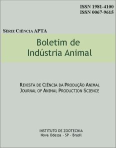Comparative efficiency and yield in different systems and densities at the nursery culture phase of the oyster Crassostrea gigas in southern Brazil
DOI:
https://doi.org/10.17523/bia.v71n2p114Palavras-chave:
Crassostrea gigas, growth, nursery, production, seedsResumo
This study was conducted to compare different aquaculture systems and seed densities for the nursery phase ofCrassostrea gigas in Brazil. Small oyster seeds (2 mm in height) reared in three nursery systems (same area/floor), a lantern net, a bouncing bucket or a floating box were compared with three initial stocking densities (50, 100 and 200 mL of seeds/system floor). As density increased, there was a significant decline in seed growth and yield, mainly in the lantern nets (P=0.0002). Better yields were observed in the box (P=0.005) and bucket systems (P=0.02) under densities of 50 and 100 mL. However, at the highest density, the nursery box system had the highest seed yield when compared to the lantern net and bucket systems (P=0.003). The results showed that the floating box was the most efficient system tested with a survival of 54% at a density of 100 mL. This was more than twice the survival for the same volumes used in the nursery lantern nets (24%), which was the most common culture method in Brazil prior to this experiment (2002). An additional advantage is the reduced cost of starting with 2.0 mm seeds that cost 50% less than the usual 4.0 to 8.0 mm seeds. These results showed the efficiency of the floating box system, which is currently used by over 90% of oyster producers in Brazil.Downloads
Downloads
Publicado
Edição
Seção
Licença
Os autores não serão remunerados pela publicação de trabalhos, pois devem abrir mão de seus direitos autorais em favor deste periódico. Por outro lado, os autores ficam autorizados a publicar seus artigos, simultaneamente, em repositórios da instituição de sua origem, desde que citada a fonte da publicação original seja Boletim de Indústria Animal. A revista se reserva o direito de efetuar, nos originais, alterações de ordem normativa, ortográfica e gramatical, com vistas a manter o padrão culto da língua e a credibilidade do veículo. Respeitará, no entanto, o estilo de escrever dos autores. Alterações, correções ou sugestões de ordem conceitual serão encaminhadas aos autores, quando necessário. Nesses casos, os artigos, depois de adequados, deverão ser submetidos a nova apreciação. As opiniões emitidas pelos autores dos artigos são de sua exclusiva responsabilidade. Todo o conteúdo deste periódico, exceto onde está identificado, está licenciado sob a Licença Creative Commons Attribution (CC-BY-NC). A condição BY implica que os licenciados podem copiar, distribuir, exibir e executar a obra e fazer trabalhos derivados com base em que só se dão o autor ou licenciante os créditos na forma especificada por estes. A cláusula NC significa que os licenciados podem copiar, distribuir, exibir e executar a obra e fazer trabalhos derivados com base apenas para fins não comerciais.













